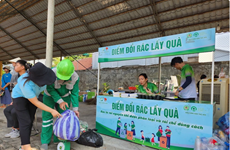Projects aim to keep rivers above water
The Red-Thai Binh rivers system has many irrigation works and four big dams to regulate water resources, but drought, shortage of water and floods are still common occurrences.
 A corner of Thac Ba Dam (Photo:VNA)
A corner of Thac Ba Dam (Photo:VNA)The four dams on the Hong (Red) and Thai Binh rivers account for millions of cubic metres of water flowing through them.
Meanwhile, solutions to maintain a stable flow, reduce pollution and salt-water contamination, as well as illegal sand mining were still inadequate, Bui Nam Sach, Head of the Ministry of Agriculture and Rural Development's Institute of Water Resources Planning (IWRP), said at a recent seminar on the final result of the IMRR project in Hanoi.
The Integrated and Sustainable Water Management of Red-Thai Binh Rivers (RTBR) System in a Changing Climate project is a cooperation between the IWRP and Italy's Milano Technology University (POLIMI).
Funded by the Italian Foreign Affairs Ministry, the 1.7-million euro project's goal was to identify strategies for the sustainable management of the RTBR system, possibly improving the current operation.
The strategy is expressed by an operating policy suggested daily, and on the basis of the observed system's condition such as the day-of-the-year and the level in each reservoir.
Project co-ordinator Professor Rodolfo Soncini-Sessa said at the seminar that the IMRR had evaluated the effects of strategic reservoir releases on the downstream system, identified efficient management policies that 'maximise' satisfaction for all the sectors while developing a decision support system known as Red-TwoLe that implements the best compromise policy.
Prof. Smcini-Sessa said, however, that the project predicted challenges that emerged later. They included the river bed incision, and sand mining and bifurcation evolution of the Duong and Hong (Red) rivers, and deforestation.
After three years of implementation, which wrapped up this month, the project showed effective results. These included completion of the Red-TwoLe, which can run as the International Water Resources Programme (IWRP) for planning and management, he said.
He said the project proved that the performance of the RTBR system could be improved and climate change would have a significant impact that can be mitigated by adapting the policy with the Red-TwoLe. It has also predicted that the Duong river is going to become the main branch of the Red River Delta, with serious agricultural consequences.
"The average rate of sand mining is 21 million cu.m per year now, if it continues unchanged, the Red river bed incision is expected to proceed further to about 70cm in the next 10 years," Soucini-Sessa said.
The IMRR addressed the design of the daily operations of the four strategic multi-purpose reservoirs of the Son La, Hoa Binh, Thac Ba and Tuyen Quang in an effort to reduce power shortage between 10 percent and 33 percent, 70 percent loss caused by floods, particularly those that threaten the capital and 93 percent shortage of safe water supply for the delta, the Italian expert said.
After the project the Red-TwoLe is transferred to the Vietnamese Ministries of Agriculture and Rural Development, Resources and Environment, and the IWRP for planning and investment, they would be able to regulate water resources on the RTBR system in the future in a sustainable way, he said.-VNA












